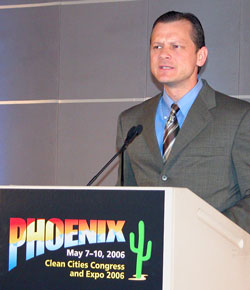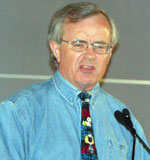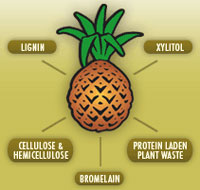 This morning’s opening session featured a speech by J.J. Brown, Legislative Aide for Utah Senator Orrin Hatch. He just finished.
This morning’s opening session featured a speech by J.J. Brown, Legislative Aide for Utah Senator Orrin Hatch. He just finished.
This is a long audio file but I think he gave an excellent talk putting into perspective the oil and energy situation on a worldwide level.
Some points that he made include the following. He wanted to bust the myth that oil company profits and the salaries of their CEO’s is responsible for the high price of gas. It’s just not true. He said that taxing oil company profits and giving that money to tax funded government programs like Medicare won’t help generate a single drop of oil. The real reason behind oil price increases he says is the supply and demand situation. Demand is outpacing supply. Simple economics. In fact, he says that the only way our oil companies can hope to compete and develop new resources is with profits which are a result of demand.
One point he made that I thought helped put things in perspective is how much of our world’s oil supply is owned by governments. Our government owns none by comparison. Our oil companies own a fraction of the current oil supply.
In the short term he thinks alternative fuels will go a long way to help us feed our hunger for fuel. He said that his boss, the Senator, fully supports renewable fuel alternatives and providing assistance to companies and organizations who want to build facilities to develop the various alternatives.
I recommend you listen to his talk:  JJ Brown Speech (30 min MP3)
JJ Brown Speech (30 min MP3)
Domestic Fuel coverage of the Clean Cities Congress is made possible by the following sponsors:


 Our sponsor for coverage of the Clean Cities Congress is Southern California Gas Company, a Sempra Energy Utility. So I was very happy to meet the guys pictured here. They are Mike Franco, Stan Sinclair, Ed Harte and Michael Bolin.
Our sponsor for coverage of the Clean Cities Congress is Southern California Gas Company, a Sempra Energy Utility. So I was very happy to meet the guys pictured here. They are Mike Franco, Stan Sinclair, Ed Harte and Michael Bolin. Ed Harte Interview (8 min MP3)
Ed Harte Interview (8 min MP3)



 Annabel Cook, Honda, pictured here with Ed Huestis,
Annabel Cook, Honda, pictured here with Ed Huestis,  Giving us a light-hearted look at alternative fuels as only he can, Jim Kenzie, Chief Auto Reviewer for the
Giving us a light-hearted look at alternative fuels as only he can, Jim Kenzie, Chief Auto Reviewer for the 
 A Florida-based company is working to make ethanol from pineapples. Biomass Resources Corporation of Boca Raton reportedly has “achieved initial success at extracting Ethanol from pineapple fruit and pineapple plant waste,” according to a
A Florida-based company is working to make ethanol from pineapples. Biomass Resources Corporation of Boca Raton reportedly has “achieved initial success at extracting Ethanol from pineapple fruit and pineapple plant waste,” according to a  It is day three of the Clean Cities Conference in Phoenix, and the convention center is packed with conference goers, all here for the same cause. With dozens of sessions, exhibits, ceremonies and receptions, people attending the conference are promised hours of information and entertainment. The crowds of people filling the convention center cannot be filed into one specific stereotype, as business people, hippies, yuppies, truckers and more can be seen in all directions. This just goes to show that the topic of alternative fuels is one which appeals to many different demographics.
It is day three of the Clean Cities Conference in Phoenix, and the convention center is packed with conference goers, all here for the same cause. With dozens of sessions, exhibits, ceremonies and receptions, people attending the conference are promised hours of information and entertainment. The crowds of people filling the convention center cannot be filed into one specific stereotype, as business people, hippies, yuppies, truckers and more can be seen in all directions. This just goes to show that the topic of alternative fuels is one which appeals to many different demographics.  Lowering the cost of ethanol production is the goal of
Lowering the cost of ethanol production is the goal of  The annual Clean Cities Coordinator awards were presented by Gunnar Lindstrom, American Honda Company. The first award was the “Leadership Award.” This was presented to Linda Urata, Valley Clean Cities, California.
The annual Clean Cities Coordinator awards were presented by Gunnar Lindstrom, American Honda Company. The first award was the “Leadership Award.” This was presented to Linda Urata, Valley Clean Cities, California. Next up on stage was the winner of the “Coordinator’s Choice” Award. This year that is Kellie Walsh, Central Indiana Clean Cities Alliance. Kellie was chosen by her fellow Coordinators from around the country.
Next up on stage was the winner of the “Coordinator’s Choice” Award. This year that is Kellie Walsh, Central Indiana Clean Cities Alliance. Kellie was chosen by her fellow Coordinators from around the country. And the winner of the “Coordinator of the Year Award” is Johathan Overly, East Tennessee Clean Fuels Coalition. All the winners were presented with award trophies. I think Jonathan will also receive free registration at a number of industry events over the next year which will be very helpful to his conference budget.
And the winner of the “Coordinator of the Year Award” is Johathan Overly, East Tennessee Clean Fuels Coalition. All the winners were presented with award trophies. I think Jonathan will also receive free registration at a number of industry events over the next year which will be very helpful to his conference budget. The person who first contacted me about blogging the Clean Cities Congress was Kimberly Taylor, shown in the picture second from left.
The person who first contacted me about blogging the Clean Cities Congress was Kimberly Taylor, shown in the picture second from left. This morning’s opening session featured a speech by J.J. Brown, Legislative Aide for Utah Senator Orrin Hatch. He just finished.
This morning’s opening session featured a speech by J.J. Brown, Legislative Aide for Utah Senator Orrin Hatch. He just finished. Speaking of alternative fuel vehicles. Here’s another way to get around in Phoenix without too many noxious gas emissions.
Speaking of alternative fuel vehicles. Here’s another way to get around in Phoenix without too many noxious gas emissions.